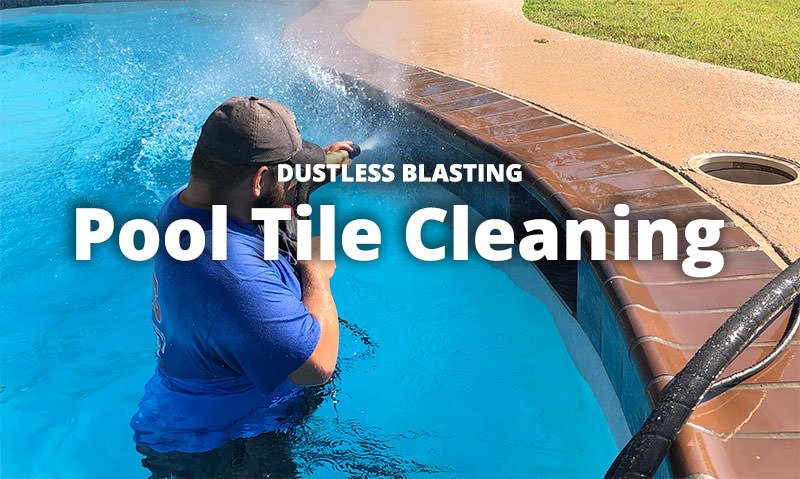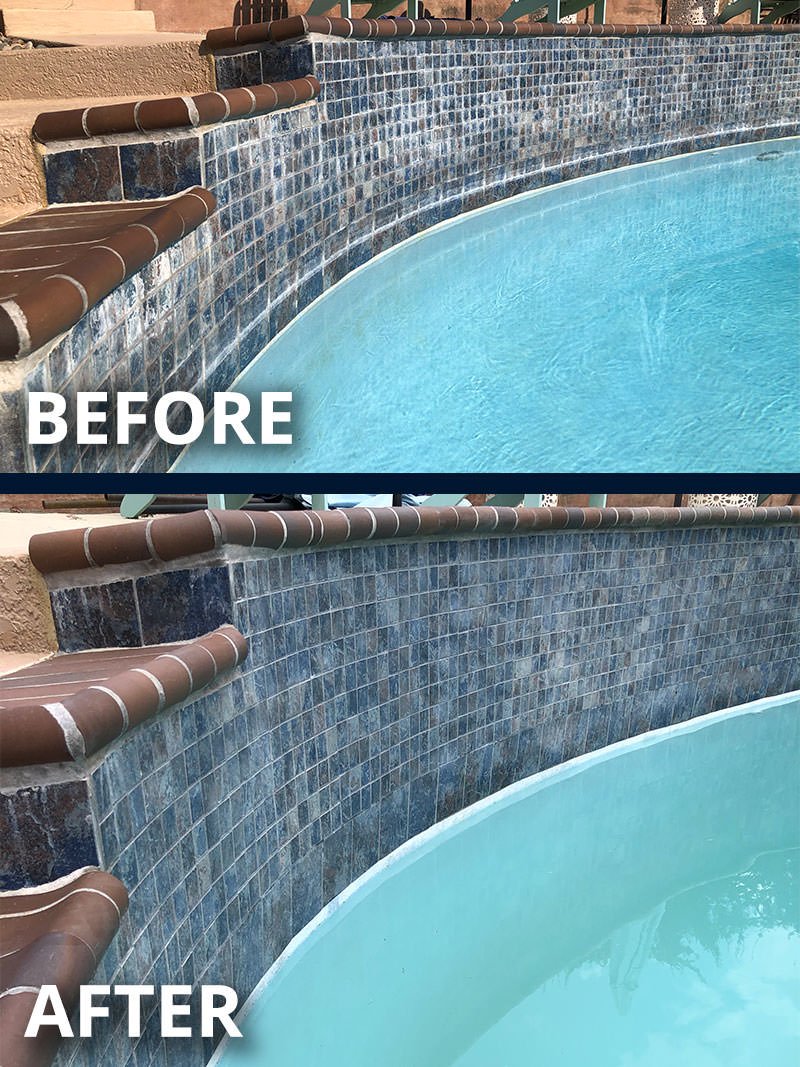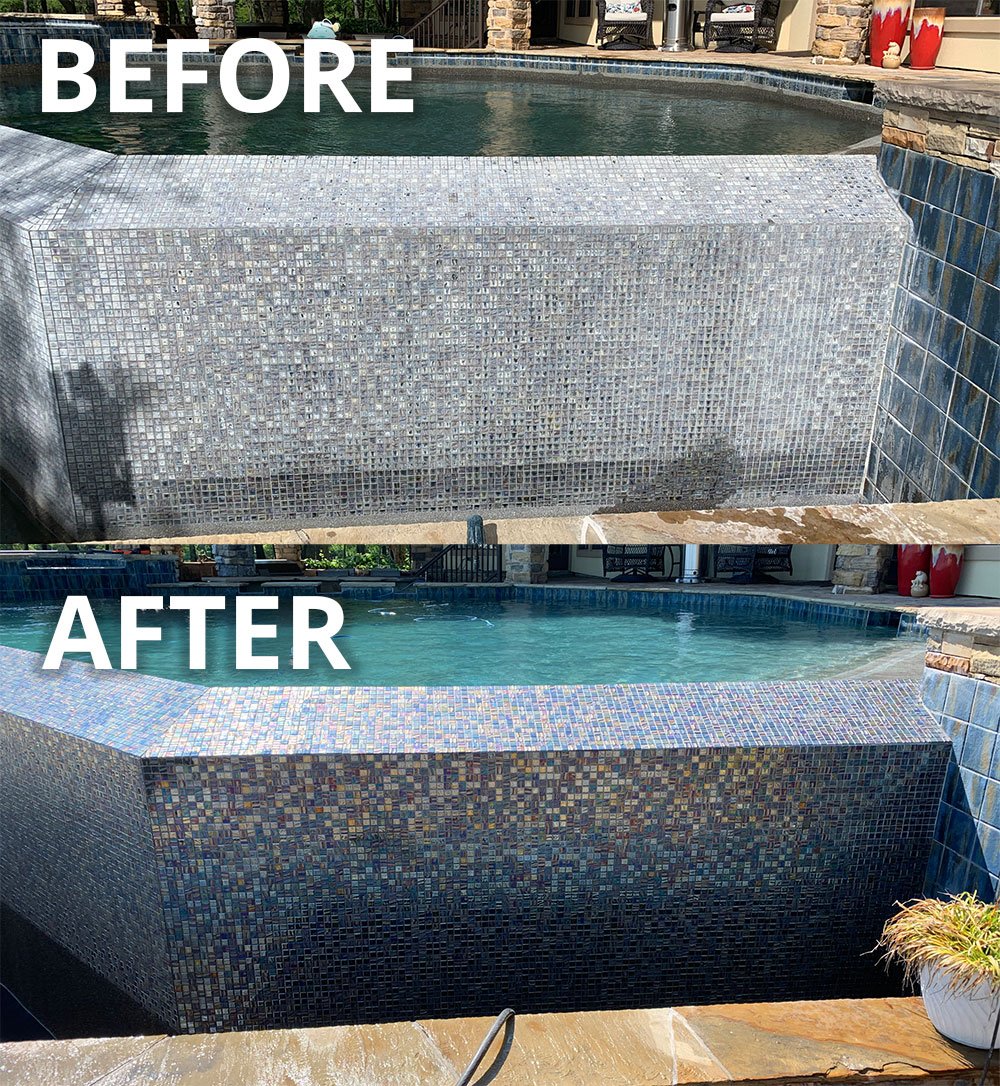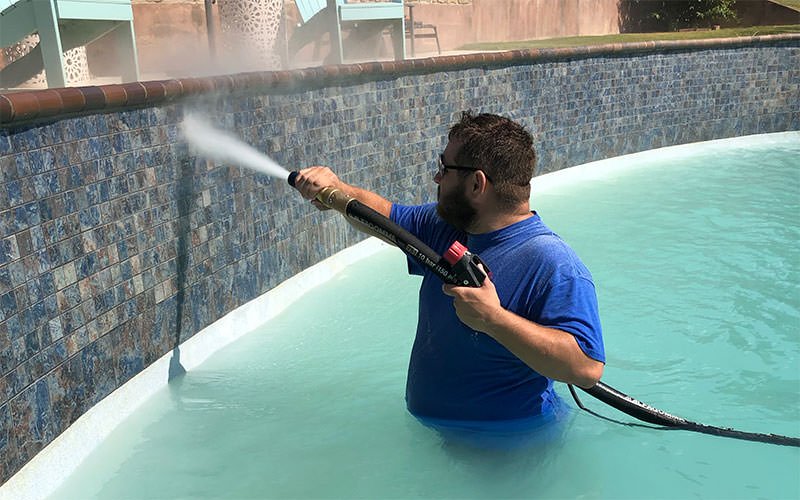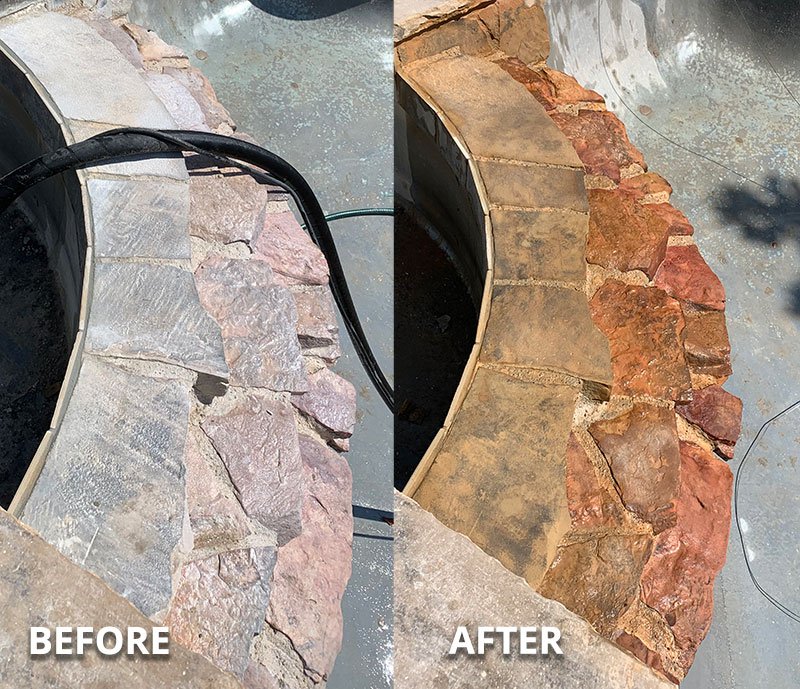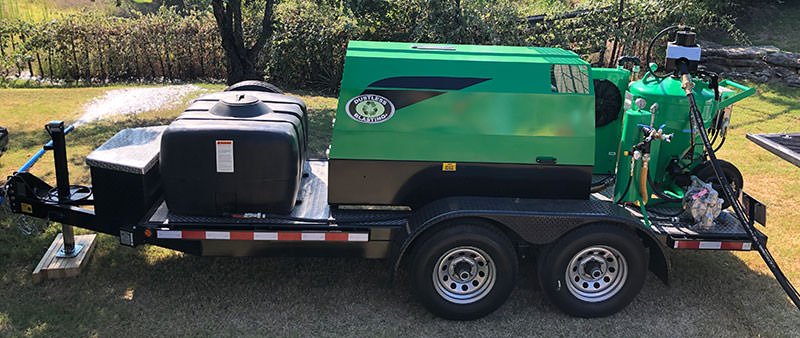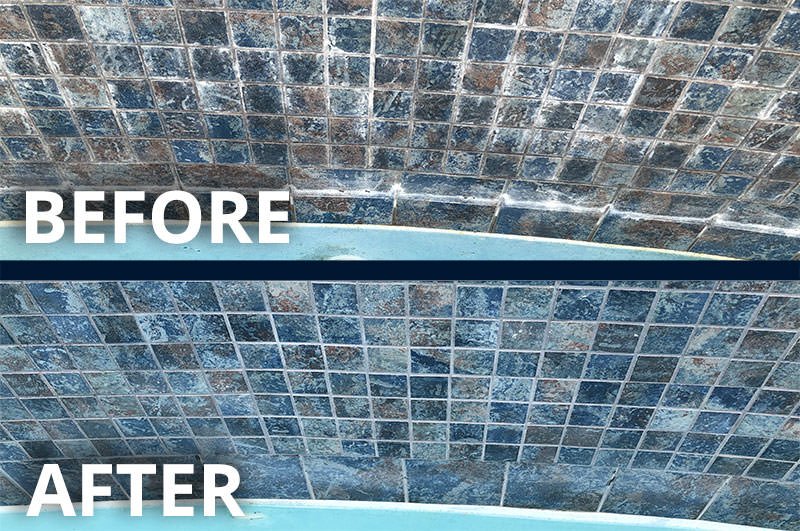Swimming is a great American pastime, which explains why there are over 10 million residential pools in the United States.
Over half are inground.
But it isn’t just a matter of filling it up and jumping into the water. Pools require regular maintenance. It’s not just a matter of aesthetics but for safety reasons too.
To keep a pool clean and running properly you must:
- remove debris floating in the water that can clog the filter system
- add chemicals to the water to keep bacteria and other disease-causing organisms under control
- get rid of algae and mold from the surfaces.
- remove calcium from the pool tile and rocks
All of these tasks take time and attention from the pool owner.
DIY Methods of Pool Tile Cleaning
You should make pool maintenance an ongoing job. That way, you can keep on top of it before scales on the tiles harden and make it more difficult to remove.
You can take care of it manually using a nylon bristle brush or pumice stone if it’s really bad.
You can also opt to use a pressure washer. It may sound easy, but a lot of times power washing your pool tile doesn’t remove all of the surface buildups.
Alternatively, you can choose an acid solution. It’s also quick and thorough. As the name implies, there are safety risks with using harsh chemicals. There were over 13,000 poisoning injuries between 2015 and 2017 alone.
Cleaning Pool Tile by Hand
If you’re wondering how to remove calcium deposits on pool tile, break out the elbow grease. This method is safer than the other two, but it’s more time-consuming. You’ll need some calcium releaser to make removal quicker. You can find these products at a home improvement center or pool shop. Look for ones that are non-toxic so that it won’t foul the water.
You may have read about other options such as cleaning pool tile with baking soda, CLR, vinegar, or other household products. Unfortunately, they are not as effective. Also, the ingredients in CLR may react chemically with chlorine and create noxious fumes. There’s also a risk of damage to the tiles.
You may need to drain the pool to get to the surface line of buildup in your pool.
Then, it’s a matter of spraying, waiting for the product to penetrate the mineral deposits, and scrubbing. You can use a pumice stone if your pool tiles are plaster or concrete. You’ll need to opt for a nylon brush if they are a softer material like fiberglass.
The advantage of this technique is that it’s inexpensive. And if your pool isn’t large, you can get it done in an afternoon, especially if you recruit the kids to help with the task. It’s best used for touch-up cleaning and routine maintenance to keep calcium scaling in check.
Pressure Washing to Clean Pool Tile & Surface Features
This method removes the chemical factor but introduces some other safety considerations. You will need to drain the pool to clean it thoroughly. You can rent a pressure washer for the afternoon from your local home improvement center for under $50 with a deposit.
You can remove scaling by blasting a heated and pressurized stream of water on the pool tiles. The combination of the two forces will get rid of the stains without creating harmful fumes. However, the pressure of the jet stream can reach 2000 PSI or more. It can penetrate your skin and cause serious injuries. The heat of the spray can also reach temperatures over 200 degrees Fahrenheit.
Therefore, it’s imperative that you read the manual and understand all the safety precautions before you operate the washer. Make sure that all the connections inside of your pool are secure. You must also wear protective gear such as goggles, rubber gloves, and ear protection. It’s also essential to wear long pants and a long-sleeved shirt along with closed-toe shoes.
You should clean pool tile with a pressure washer at the lowest setting first. Use a sweeping motion to flush out debris and dirt. If it is the first time you’ve used this type of device, you should test a small patch before tackling the entire job. Then, proceed to spray section by section.
Never point the nozzle at yourself or anyone else.
When you’re finished, turn the unit off and disconnect the water supply. Then, pull the trigger to release any pressure that may exist in the tank. This method is effective when used as directed. However, you cannot use a well or pond as your water source.
Acid Solution to Clean Pool Tile
This final DIY option works well but involves the use of toxic chemicals and more work to clean up when you’re done. You will have to drain the pool before you start. You must also wear protective gear, including a chemical-resistant suit and respirator during the entire procedure because of the risk of noxious fumes.
The solution you will use is a diluted acid mixture using muriatic or hydrochloric acid. This chemical is highly caustic, so it’s imperative you proceed cautiously. The supplies you’ll need include:
- Acid-resistant plastic container
- Spray bottle
- Garden hose
- Baking soda
- Nylon bristle brush (optional)
- Soda ash
You’ll need a hose and sodium bicarbonate for safety in case you spill any of the muriatic acid. The latter will neutralize it quickly to help any serious injuries.
Mix a 1:16 solution of acid to water.
You must add the acid to the water and not the other way around since it can react violently and splash you. Then, fill the spray bottle.
As with the pressure washer, you’ll go section by section. Make sure the area is well-ventilated. Apply the solution and let it sit for several minutes to penetrate. You may need to follow up with scrubbing for tough stains. Once you’re done, you’ll need to add soda ash to the water at the bottom of the pool to neutralize it and render it harmless for disposal.
Use about 2 pounds for every gallon of fluid.
Pump the treated water out and give it a final rinse with plain water. It’s imperative to thoroughly clean any containers you used to prevent unexpected chemical reactions the next time you fill them. Take the same precaution with any gear or clothing you wore during the clean-up. You should also check with your local municipal waste facility about disposing of any leftover muriatic acid.
While scrubbing is the safest of the three, it’s also the most time-consuming.
The use of specialized equipment makes pressure washing riskier even without the harsh chemicals. While acid washing is highly effective, it also has issues that may make it inappropriate in some cases. Its best use is for stubborn stains and excessive calcium buildup when you have an entire day to do the job.
At this point, you’re probably wondering about how to clean pool tile that doesn’t involve so much work. Fortunately, there’s an easy answer to that question.
Hire the Pool Tile Cleaning Professionals at Willsha Pools
You can skip all the bother and mess involved with pool cleaning and hire a professional pool tile cleaning service instead. There are several advantages to this option.
- We have all the equipment and supplies. You don’t need to hunt down soda ash or rent a pressure washer.
- We also have the experience to do the job right. That also includes proper disposal and cleanup throughout the process.
- You can set up a regular maintenance schedule to ensure that all the necessary tasks are done. It will extend the life of your pool, filter, and any other components by keeping the water clean and free of debris that could cause damage.
Your pool will look as pleasing and inviting as the day you had it installed.
We can also look over your filtration system before an issue becomes an expensive repair. Considering that the average cost to install an inground pool tops $35,000, it’s a worthwhile investment.
Pool Tile Cleaning Equipment
Professional pool technicians use many of the same materials as you might for a DIY project.
However, we have the expertise to optimize the process and your maintenance regime. Willsha Pools can recommend the right products to use for your pool and usage. We can also bring out various equipment when the situation calls for it.
Power washing is adequate if all you need is to have your pool cleaned. Over time, the tile may get stained from everyday use. Algae may take its toll on the shine and vibrancy of the colors. Sunlight can also do a number of its appearance. And sometimes no amount of scrubbing or acid washing will restore it.
That’s when you’ll need to consider resurfacing your pool.
More powerful washers can scrape off chips and get the ball rolling. A better option is to use dustless blasting.
Not only will it clean the pool, but it will also remove any coatings to give it a fresh slate and make your pool look new again.
Dustless Blasting Advantage for Pool Cleaning
You may wonder what is dustless blasting, and is it right for me?
Using a pressure washer only cleans the surface. Dustless blasting uses non-toxic materials like recycled glass to provide the abrasive action instead of the high-pressure water spray. The combination of the two ramps up the efficiency for better results.
Dustless blasting is an economical choice because it uses less water. Instead of the hundreds of gallons a power washer uses, these machines take only about 20 gallons per hour.
It’s safer for the environment and won’t harm any landscaping around your pool. The material used is also compliant with OSHA regulations.
The blaster can also clean rocks that you may have around your pool for a complete makeover.
Willsha Pools also uses our dustless blasting equipment to remove paint from pool surfaces and decks to get the surface ready for refinishing quicker.
Dustless blasting won’t give off heat like a pressure washer, so there’s no risk of warping. Nor will it emit toxic fumes like acid washing. The heavier weight of the abrasive materials ensures that it won’t drift.
Because it’s eco-friendly, you needn’t worry about keeping pets and children away while you get your pool cleaned.
Dustless blasting can remove any grime or coatings, it doesn’t matter how much buildup there is in or around your pool.
Dustless vs. Soda Blasting Pool Tile
Soda blasting is similar to the dustless method. However, it uses sodium bicarbonate instead of glass beads. It releases a finer spray that makes it a suitable choice for more fragile materials like ceramic tile. However, it has one glaring disadvantage—its effect on your pool water pH. Since it is a base, any residual materials will create a more alkaline environment.
Likewise, salt blasting can clean the surface of tile effectively. But like sodium bicarbonate, it has its drawbacks too. Excessive salt can kill ornamental plants and damage your lawn. On the positive side, it is pH-neutral and won’t affect the chemistry of your pool water.
Preventing Calcium Buildup in Your Pool
Stains and calcium deposits can interfere with the enjoyment of your pool. The best way to keep the situation under control is regular maintenance that your pool service can provide. You can also take a proactive approach and test the hardness of the water periodically to ensure that the calcium is between 200 and 400 parts per million.
If it’s too low, it can make the water corrosive and wreak havoc with any metal components or concrete. Likewise, high levels can cause the unsightly buildup on the tiles. Your pool technician can recommend sequestering products that will prevent it.
Dustless blasting offers an excellent way to surface clean your pool and restore the vibrancy of the tiles to its brand-new state. It is both safe and environmentally friendly without the concerns of using toxic chemicals.
Call us today for more information, a free quote, and professional consultation for the best way to clean your pool tile and surrounding areas.

